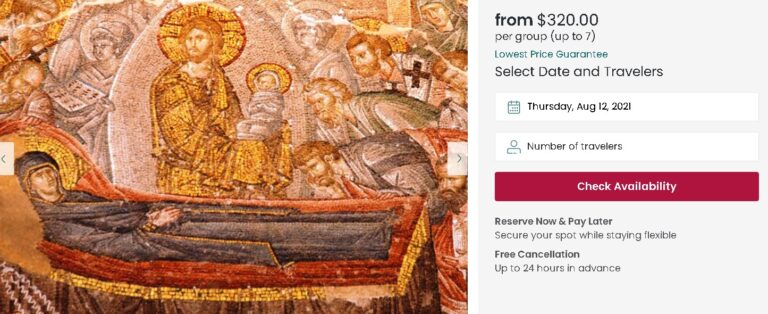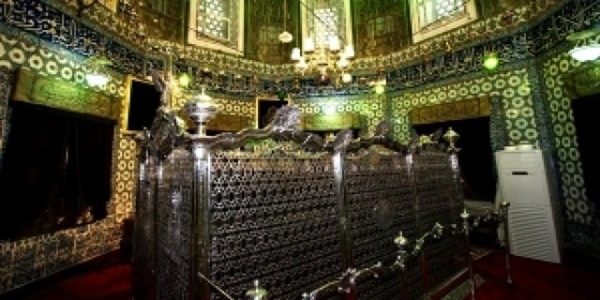
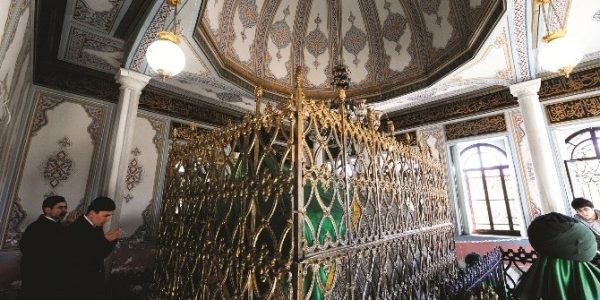
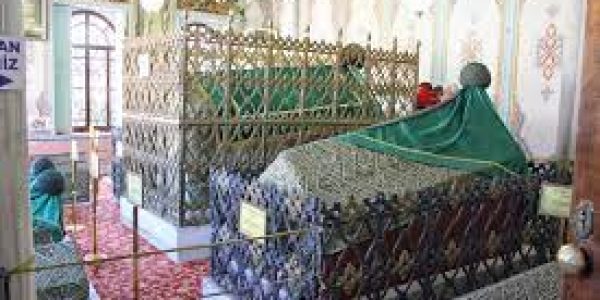
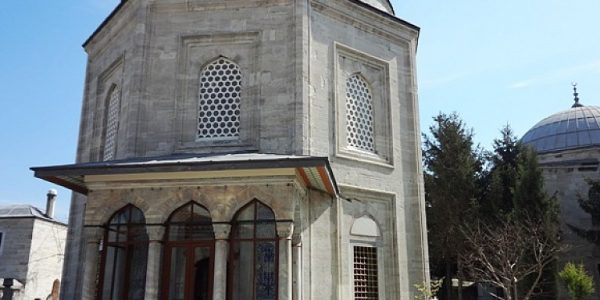
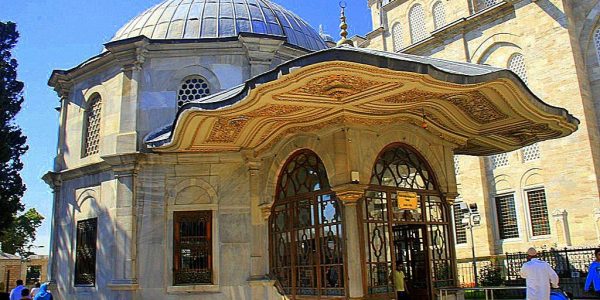
HOLY TOMBS OF ISTANBUL
AZIZ MAHMUT HUDAI TOMB
Aziz Mahmud Hudayi was a well-known religious figure in Istanbul. His sheikh gave him the names “Hudayi” and “Aziz.” Aziz Mahmud Hudayi constructed the dargah (shrine) in the same-named area of Uskudar between 1594 and 1595. In the tekke (dervish lodge) that was constructed as a social complex, there is a kitchen, a graveyard, a tomb, a mosque, a tevhidhane (house of ceremonies), library, women’s section, and homes.
The mausoleum is open to the public every day of the week between the hours of 07.30 and 20.00.
Address: Aziz Mahmud Hudayi Mah. Aziz Mahmud Efendi Sok. Cami Ici No:1 Posta Kodu: 34672 Uskudar/Istanbul
EYUP SULTAN TOMB
The mausoleum is in front of the inner courtyard of Eyup Sultan Mosque, to the north. It was built about 1454-55 by Ottoman monarch Mehmed the Conqueror (Mehmed II). Eyup Sultan (Abu Ayyub al-Ansari), one of the prophet’s closest associates, is the first person to welcome Prophet Muhammad following his departure from Mecca to Medina.
Address: Merkez Mah. Cami Kebir Sok. No:1, 34050 Eyup/Istanbul
SULEIMAN THE MAGNIFICENT TOMB
Mimar Sinan created Suleiman the Magnificent’s Tomb, which is located inside Suleymaniye Mosque, in 1566. Suleiman the Magnificent died in Szigetvár, Hungary, on September 7, 1566.
The tomb was later used to bury his body. On the grave, there is a dome with a blue hoop. Visitors will also observe that the hoop has Quran passages written on it. At the tomb’s entrance, there are two windows. Suleiman the Magnificent’s Tomb has the “sandukas” (Sanduka: Sarcophagus made of wood or marble, put over the tomb) of Sultan Suleiman II, Sultan Ahmed II, Mihrimah Sultan, Saliha Dilasup Valide Sultan, Asiye Sultan, and Rabia Sultan, as well as the sarcophagus of Suleiman the Magnificent.
Address: Suleymaniye Mah. 34116 Fatih/Istanbul
HURREM SULTAN TOMB
In 1506 was born Hurrem Sultan, the wife of Ottoman Emperor Suleiman the Magnificent. Hurrem Sultan is also the mother of Selim II, as she was the Sultan’s first wife. The Hurrem Sultan Tomb is part of the Suleymaniye Mosque complex in Eminonu.
The tomb is located close to Suleiman the Magnificent’s mausoleum. This tomb, which is one of Istanbul’s most visited, was created by Mimar Sinan in 1558 at the behest of Hurrem Sultan. From the outside, the tomb was octagonal, and from the inside, it was hexagonal.
Address: Suleymaniye Mah. 34116 Fatih/Istanbul
MIMAR SINAN TOMB
The mausoleum is placed in a triangular space across from Suleymaniye Mosque’s Eski Agalar Gate on the corner. Mimar Sinan created the mausoleum himself, with six columns, a roof, a solid gold fountain, and open environs, just before his death.
The Suleymaniye and Selimiye Mosques, which are among the most renowned works of global architecture, are also among the masterworks of Mimar Sinan, the most important figure in the history of Turkish architecture who served as Suleiman the Magnificent’s master architect from 1490 to 1588.
Address: Suleymaniye, Mimar Sinan Cad. No:52, 34116 Fatih/Istanbul
SULTAN AHMED I TOMB
Sultan Ahmed I Tomb, which is part of the Sultan Ahmed Compound, is located in Sultanahmet Square in the northeast corner of the complex. Architect Mehmed Agha began building on the Sultan Ahmet Social Complex in 1609, and it was completed in 1620, three years after Sultan Ahmed’s death. The mosque, sultan’s palace, outer court, and markets were the first components of the complex to be finished, while the hospital, madrasa, and tomb were the last. The tomb contains the graves of 36 people.
Address: Sultan Ahmet Kabasakal Cad. Nalbasti Sok No:2, 34122 Fatih
SEHZADE MEHMED TOMB
Suleiman the Magnificent commissioned Mimar Sinan to construct a mosque in his honor, and he named it after prince Sehzade Mehmed, who died young. For the prince, a very exquisite tomb was also built. During the construction of the tomb, Mimar Sinan chose ceramics in colors that could only be found on a young prince’s robe, such as yellow and green. This feature of the tomb sets it apart from other Ottoman tombs. Inside the ceramics that would surround the tomb, Quran verses, primarily the Ayat al-Kursi (“Throne Verse”), were inserted.
The wooden construction above Sehzade Mehmet’s sarcophagus attracts visitors to the grave. It was Suleiman the Magnificent’s throne that was reversed and put on the sarcophagus. Sehzade Cihangir was buried here as well. Two marble sarcophagi have been erected for Ibrahim Pasha’s son and daughter, who died as children.
Address: Kalenderhane, Sehzadebasi Cad. No:44, 34134 Fatih/Istanbul
YAVUZ SULTAN SELIM TOMB
Suleiman the Magnificent erected the tomb in remembrance of his father, Selim I, between 1516 and 1522 on a hill overlooking the Golden Horn in Fatih. Inside the compound, there is a mosque, an imaret, a school, a hospital, a bath, and graves. The tomb’s architect is unknown, however, based on its construction, it is considered to have been erected by Mimar Acem Ali.
The burials of Suleiman The Magnificent’s young girls and sons can be located in an adjacent tomb with comparable architectural elements. The mosque, tombs, and the elementary school building at the entrance of the outer courtyard are the only structures of the complex that have remained to this day.
Address: Balat, Sultan Selim Cad. No:18, 34087 Fatih/Istanbul
SULTAN RESAD TOMB
Sultan Resad Tomb is a tomb in Istanbul’s Eyupsultan district where Sultan Resad, also known as Mehmed V, the 35th Ottoman Sultan, is buried. Architect Kemaleddin Bey built this tomb between 1911 and 1912 to represent the concept of national architecture.
Address: Eyup Merkez, Karakol Arkasi Sok. No:3, 34050 Eyupsultan/Istanbul
YUSA TOMB
Yusa Tomb is situated on Yusa Hill, Beykoz’s highest point at 200 meters above sea level and the closest point to the sea. Unlike other tombs, Yusa Tomb is a religious site that is revered by people of all faiths. Prophet Joshua is a descendent of Prophet Joseph’s lineage and was born with the goal of preaching Islam. Joshua was born in the Egyptian capital of Cairo. Joshua, according to legend, once traveled to the Bosporus with Moses. He died here after a while and was buried at what is now known as Yusa Hill. While Muslims refer to the prophet as “Hz. Yusa,” Jews and Christians refer to him as “Joshua.”
Another feature of the tomb is that the portion believed to be Joshua’s is exactly 17 meters long. This is due to the fact that a 17-meter-wide area was set aside for Joshua’s burial site, the exact location of which remains unknown.
Address: Anadolu Kavagi, 34825 Beykoz/Istanbul
SULTAN MAHMUD II TOMB
Sultan Mahmud II Tomb, located on Divanyolu Avenue in Cemberlitas, was built in 1839 on Sultan Abdulmejid’s request for his father Mahmut II by the Dadyan brothers Ohannes and Bogos. Sultan Mahmud II Tomb, which was finished in 1840, bears the look of an Ottoman mausoleum covering a huge area. The mausoleum was created in an octagonal shape, with a fountain, muvakkithane (structure for those establishing the time for azan), and a restricted area. Many administrators, writers, and poets who lived between 1840 and 1920 are buried here.
Address: Mollafenari, Turbedar Sok. No:15, 34120 Fatih/Istanbul
LALELI SULTAN MUSTAFA III TOMB
Architect Mehmed Tahir Agha constructed Sultan Mustafa III Tomb between 1759 and 1763. At the Nuruosmaniye Tomb, which is part of Mustafa III’s Laleli Social Complex, one can witness the impact of the West, as shown on the Nuruosmaniye Tomb. Apart from Mustafa III’s grave, the tomb contains the graves of Selim III, Heybetullah, and Fatma Sultan.
Address: Kemal Pasa, Sirvanizade Sok. No:1, 34134 Fatih/Istanbul

